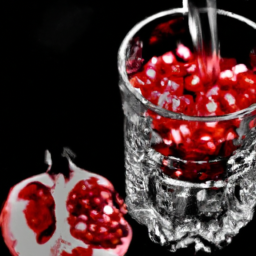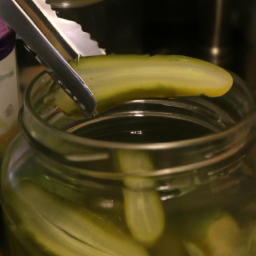I have always loved pomegranates for their tangy yet sweet flavor and vibrant, deep red color. It was only recently that I discovered the many health benefits that this superfood provides.
Packed with antioxidants, vitamins, and minerals, pomegranates have been shown to help improve heart health, lower blood pressure, and reduce inflammation in the body. And what better way to enjoy all of these benefits than to juice fresh pomegranates at home?
In this article, I’ll walk you through the steps for juicing pomegranates in a juicer. I’ll cover everything from choosing the right juicer to preparing the fruit, and I’ll share some tips for storing and using the juice.
So whether you’re a seasoned juicer or a beginner, this guide will help you get the most out of your pomegranates and enjoy all of the health benefits they have to offer.
Key Takeaways
- Choosing the right juicer is important, with masticating juicers being more efficient.
- Preparation involves cutting the fruit and removing the seeds, with a fine mesh strainer recommended for straining the juice.
- Sweeteners like honey, maple syrup, stevia, or agave nectar can be added for taste, but avoid using a blender or mixer to prevent changes in taste and texture.
- Stir the sweetened juice gently with a spoon or whisk and store in a container after stirring.
Choose the Right Juicer
You’ll want to make sure you’ve got the right kind of juicer – don’t worry, it’s easy to find one that’ll make juicing pomegranates a breeze!
There are two types of juicers you can choose from: centrifugal and masticating. Centrifugal juicers are the most common and affordable type of juicer. They work by using a high-speed spinning blade to chop up the fruit and extract the juice. However, these juicers may not be the best for pomegranates as they may not fully extract all the juice and can leave behind a lot of pulp.
Masticating juicers, on the other hand, are slower but more efficient. They use a slow, grinding motion to extract the juice and leave behind less pulp. Some masticating juicers even have a separate attachment specifically for juicing pomegranates.
When choosing a juicer, look for features such as a wide feed chute, easy-to-clean parts, and adjustable settings for different types of fruits and vegetables. With the right juicer, juicing pomegranates will be a breeze.
Now that you have your juicer, it’s time to prepare the pomegranate for juicing.
Prepare the Pomegranate
When I prepare a pomegranate for juicing, there are two important steps: cutting the fruit and removing the seeds.
To cut the pomegranate, I first wash it thoroughly and then slice off the crown at the top. Then, I score the skin in four places and use my fingers to gently pull the fruit apart.
Once I have the sections separated, I can remove the seeds by gently tapping or scraping them out with a spoon.
Cut the Pomegranate
First, grab a sharp knife and slice off the crown of the pomegranate, which typically accounts for about 5% of the fruit’s weight. It’s important to be extra careful when handling the knife to avoid any potential injuries. Make sure to keep your fingers away from the blade and use a cutting board to protect your countertop.
Once the crown is removed, score the pomegranate vertically from top to bottom into four sections. Next, gently pull apart the sections to reveal the seeds. Use your fingers to loosen the seeds from the membrane and separate them into a bowl. Be sure to discard any white membrane or skin to prevent bitterness in your juice.
With the pomegranate prepared, it’s time to move on to the next step of juicing.
Remove the Seeds
After scoring the pomegranate, gently separate the sections to reveal the vibrant red seeds. To remove the seeds, hold each section over a bowl and gently tap the back of it with a spoon. The seeds will fall out easily. Removing Pomegranate Seeds: Tips and Tricks are essential to avoid the bitter white membrane and juice stains on your clothes.
Here are some creative ways to use pomegranate seeds in cooking:
- Sprinkle them on salads or roasted vegetables for a pop of color and crunch.
- Use them as a topping for oatmeal or yogurt bowls to add natural sweetness.
- Add them to smoothies for a burst of flavor and antioxidants.
- Use them in cocktails or mocktails for a festive touch.
Once you have all the seeds, you can proceed to juice the pomegranate.
Juice the Pomegranate
To juice the pomegranate, you’ll want to cut it in half and use a citrus juicer – it’s like squeezing out precious rubies from the fruit.
Not only is pomegranate juice delicious, but it’s also packed with nutritional benefits. It’s high in antioxidants, which can reduce inflammation and lower the risk of chronic diseases such as heart disease and cancer. Pomegranate juice is also a good source of vitamin C, potassium, and fiber.
There are countless recipes that incorporate pomegranate juice, from cocktails to marinades to smoothies. But before you can use it in a recipe, you’ll need to strain the juice. This removes any leftover seeds or pulp, resulting in a smooth, easy-to-drink juice.
Strain the Juice
Now that I’ve successfully juiced my pomegranate, the next step is to strain the juice.
I recommend using a fine mesh strainer to remove any seeds or pulp that may have made their way into the juice.
If the juice still has some pulp or seeds after the first straining, it’s best to strain it again to ensure a smooth and enjoyable drinking experience.
Use a Fine Mesh Strainer
Using a fine mesh strainer is the perfect way to ensure that every last drop of juice is extracted from your pomegranate. When using this method, it’s important to keep in mind a few tips and tricks to achieve the best results.
First, select a strainer with very fine mesh to ensure that no pulp or seeds make it through. Next, press down firmly on the seeds with a spoon or spatula to extract as much juice as possible. You can also gently stir the seeds in the strainer to help release any trapped juice.
While using a fine mesh strainer is the most common and effective way to strain pomegranate juice, there are alternative methods that can be used. For example, you can use a cheesecloth or muslin cloth to strain the juice. However, this method can be time-consuming and may not yield as much juice as using a fine mesh strainer.
Regardless of the method used, it’s important to strain the juice at least once to ensure a smooth, pulp-free texture. But if needed, don’t hesitate to strain twice to get the most out of your pomegranate.
Strain Twice if Needed
If you want to ensure a perfectly smooth and pulp-free texture, don’t hesitate to strain the pomegranate juice twice! Even after passing the juice through a fine mesh strainer, there may still be some small particles that could affect the texture of the juice.
Straining the juice twice will ensure that all the particles are removed, and the juice is completely smooth. When to strain pomegranate juice twice? It’s recommended to do so if you’re planning to use the juice for cocktails or for a recipe that requires a smooth texture.
Straining the juice twice is also ideal if you’re using a juicer that tends to leave more pulp in the juice. By doing so, you can enjoy a juice that’s not only delicious but also has a silky smooth texture.
Now that you have perfectly strained pomegranate juice, it’s time to add some sweetener (optional).
Add Sweetener (Optional)
For an extra touch of indulgence, you might wanna sprinkle in some honey or maple syrup to balance out the tartness of the pomegranate juice. While pomegranate juice is delicious on its own, adding a sweetener can make it more palatable for those who prefer a sweeter taste.
Here are some sweetener alternatives that work well with pomegranate juice:
-
Honey – Honey is a natural sweetener that adds a unique flavor to pomegranate juice. It also has antimicrobial properties that can boost your immune system.
-
Maple syrup – Maple syrup is another natural sweetener that complements the tartness of pomegranate juice. It is also a rich source of antioxidants and minerals.
-
Stevia – Stevia is a calorie-free sweetener that’s extracted from the leaves of the Stevia rebaudiana plant. It’s a good option for those who want to avoid sugar.
-
Agave nectar – Agave nectar is a sweetener that’s derived from the agave plant. It has a lower glycemic index than sugar, which means it won’t cause a sudden spike in blood sugar levels.
Adding a sweetener to pomegranate juice is optional, but it can enhance the flavor and make it more enjoyable to drink. Once you’ve added your sweetener of choice, stir the juice to ensure it’s well-mixed before serving.
Stir the Juice
Now, it’s time to give your sweetened pomegranate concoction a good stir to ensure that the flavors are well-distributed. Stirring is an essential step in the juicing process as it helps in evenly mixing the sweetener and the juice. However, the technique you use can affect the quality of your juice. To get the best results, stir the juice gently using a spoon or a whisk. Avoid using a blender or a mixer as they can create heat and introduce air into the juice, which can change its taste and texture.
When you’re done stirring, transfer the juice to a container for storage. The type of container you use is crucial in preserving the freshness and flavor of your juice. Glass jars or bottles with airtight lids are the best options as they prevent oxidation and keep the juice from getting contaminated. Plastic containers are not recommended as they can leach chemicals into the juice and affect its taste. Once you’ve stored your juice, it’s ready to serve or keep in the fridge for later use.
Next, let’s talk about the best ways to serve and store your freshly juiced pomegranate.
Serve and Store
I’ve found that the best time to drink pomegranate juice is in the morning, shortly after waking up. This is because the high antioxidant content can help kickstart your metabolism and provide a natural energy boost.
When it comes to storing leftover juice, it’s best to keep it in an airtight container in the refrigerator for up to 3 days to ensure freshness and prevent spoilage.
Best Time to Drink Pomegranate Juice
If you’re looking for a refreshing and nutritious drink, drinking pomegranate juice in the morning can give you the boost you need to start your day off right.
Pomegranate juice is packed with antioxidants, vitamin C, and potassium, making it a great source of nutrients that can help boost your immune system, improve your heart health, and even reduce inflammation in your body. According to research, drinking pomegranate juice regularly may also have benefits for your brain and memory, and may even help reduce the risk of certain types of cancer.
The recommended daily intake of pomegranate juice is about 8 ounces per day, which is equivalent to one small glass. Drinking pomegranate juice in the morning can be a great way to ensure that you are meeting your daily recommended intake of this superfood.
However, it’s important to note that pomegranate juice is high in sugar, so it’s best to drink it in moderation and as part of a balanced diet. If you have leftover juice, it’s important to store it properly to ensure that it stays fresh and doesn’t spoil.
How to Store Leftover Juice
After learning about the best time to drink pomegranate juice, let’s talk about what to do with leftover juice. I often find myself with extra juice after making a batch for myself, and I don’t want it to go to waste. That’s why I’ve come up with some tips for preventing leftover juice from spoiling and some creative uses for it.
Firstly, to prevent leftover pomegranate juice from spoiling quickly, it’s best to store it in an airtight container in the refrigerator. This will keep it fresh for up to 3-4 days. If you want to keep it for longer, you can freeze it in ice cube trays and use it as a flavor booster in smoothies or cocktails.
Secondly, you can use leftover pomegranate juice to make popsicles or fruit gummies. Simply mix it with some gelatin and sweetener of your choice, pour it into molds, and freeze.
Lastly, you can use it as a marinade for meats or as a salad dressing. The tartness of the juice pairs well with savory flavors and adds a unique twist to your dishes.
Now that you know what to do with leftover pomegranate juice, let’s move on to the next section where we’ll discuss the health benefits of this superfood juice.
Health Benefits of Pomegranate Juice
I’m excited to share with you the health benefits of pomegranate juice.
Did you know that it’s packed with antioxidants? Antioxidants protect our cells from damage caused by free radicals that can lead to chronic diseases.
Additionally, studies have shown that consuming pomegranate juice can help lower blood pressure and may even help fight arthritis.
Rich in Antioxidants
Pomegranates are bursting with antioxidants that can help protect your body from harmful free radicals. Antioxidants are essential in our diet because they neutralize free radicals, which are unstable molecules that can damage cells and contribute to various chronic diseases. Incorporating pomegranate into your diet is an excellent way to reap the benefits of consuming antioxidants, as this fruit is packed with polyphenols, ellagic acid, and tannins.
Here are four ways that pomegranate can help you fight off free radicals:
- Pomegranate juice has three times more antioxidants than red wine and green tea, making it a great beverage choice for those looking to boost their antioxidant intake.
- The polyphenols found in pomegranate have been shown to reduce inflammation, which is a common factor in many chronic diseases.
- Ellagic acid, a potent antioxidant found in pomegranate, has been linked to a reduced risk of certain cancers.
- Tannins in pomegranate can help prevent heart disease by reducing cholesterol levels and improving blood flow.
Incorporating this superfruit into your diet is an easy and delicious way to improve your health. Plus, pomegranate’s rich antioxidant content can help lower blood pressure, as we’ll explore in the next section.
Can Help Lower Blood Pressure
As I mentioned earlier, pomegranates are a great source of antioxidants that can help protect our cells from damage caused by free radicals. But did you know that regularly consuming pomegranate juice may also help lower blood pressure and improve cardiovascular health?
This is because pomegranate juice is rich in polyphenols, which have been shown to have a positive effect on blood pressure and overall heart health. Studies have found that drinking pomegranate juice daily can lead to significant reductions in both systolic and diastolic blood pressure.
Additionally, pomegranate juice has been found to improve blood flow and decrease the risk of plaque buildup in the arteries, which can ultimately reduce the risk of heart disease. Incorporating pomegranate juice into your diet is an easy and delicious way to support your cardiovascular health and lower your blood pressure.
As we’ve seen, pomegranate juice has a variety of potential health benefits. In the next section, we’ll explore how pomegranate juice may help fight arthritis.
May Help Fight Arthritis
You’ll be pleased to know that incorporating pomegranate into your diet may help alleviate symptoms of arthritis. Arthritis prevention and pomegranate supplementation have been linked in studies, showing promising results for reducing joint pain and inflammation. Pomegranates contain antioxidants, which help fight free radicals that can damage cells and contribute to inflammation. Additionally, pomegranates contain anti-inflammatory compounds that can help reduce joint pain and stiffness.
To give you an idea of how pomegranates can benefit arthritis sufferers, here’s a table outlining some of the key nutrients found in this fruit:
| Nutrient | Function |
|---|---|
| Vitamin C | Supports collagen production and immune system |
| Vitamin K | Helps with bone health and blood clotting |
| Polyphenols | Antioxidants that reduce inflammation |
| Flavonoids | Anti-inflammatory compounds |
Incorporating pomegranate into your diet is a simple and delicious way to potentially reduce arthritis symptoms. But that’s not the only way to use this versatile fruit. Let’s explore some other ways to incorporate pomegranate into your daily routine.
Other Ways to Use Pomegranates
When life hands you a pomegranate, don’t just juice it – explore the many other ways you can incorporate its sweet and tangy flavor into your culinary repertoire.
Pomegranate recipes are versatile and can be used in sweet and savory dishes alike. One way to use pomegranate is by adding it to salads for a pop of color and flavor. You can also use pomegranate juice as a marinade for meats or as a glaze for roasted vegetables.
Not only do pomegranates add flavor to your meals, but they also come with a host of benefits. Eating pomegranates can help improve heart health, reduce inflammation, and even fight cancer. They’re also high in antioxidants and fiber, making them a great addition to any diet.
So next time you see a pomegranate, don’t just think of it as a fruit to juice – get creative and explore all the ways you can use it in your cooking.
Frequently Asked Questions
Can I use a blender instead of a juicer to make pomegranate juice?
I wouldn’t recommend using a blender instead of a juicer to make pomegranate juice. While a blender can chop the fruit, it won’t separate the juice from the pulp like a juicer does. Juicing is the best method for pure, smooth pomegranate juice.
How long does it take to prepare and juice a pomegranate?
To prepare and juice a pomegranate efficiently, I recommend slicing off the crown and scoring the skin before submerging in water to loosen the seeds. This prep time tip can save time during juicing. Using a powerful juicer can also speed up the process.
Can I store the juice in the freezer for later use?
When it comes to storing pomegranate juice, it’s best to freeze it in an airtight container or ice cube trays for later use in smoothies or recipes. Don’t let it go to waste!
Is it necessary to strain the juice if I don’t mind the pulp?
If you don’t mind the pulp, it’s not necessary to strain pomegranate juice. In fact, juicing with pulp provides additional nutritional benefits, including fiber and antioxidants.
What are some common mistakes to avoid when juicing pomegranates?
To avoid oxidation and ensure the best quality juice, use a slow, masticating juicer for pomegranates. Mistakes to avoid include using a centrifugal juicer, not removing the seeds, and storing the juice too long.
Conclusion
So there you have it, folks – a step-by-step guide on how to juice a pomegranate in a juicer. It may seem daunting, but once you get the hang of it, it’s actually quite simple.
And did you know just how beneficial pomegranate juice can be for your health? According to a study published in the Journal of Agricultural and Food Chemistry, it has been found to have higher antioxidant activity than red wine and green tea. In fact, it has been shown to have three times the antioxidant power of red wine and green tea, making it a true superfood.
Next time you’re looking for a healthy and tasty drink, give pomegranate juice a try. Not only does it taste great, but it’s also packed with antioxidants and other beneficial nutrients that can help improve your overall health and well-being.
Cheers to good health!
Hi, I’m Alexander. I’m a vegan of over 20 years, and I initially made the switch for health reasons. However, as time went on, I became more and more passionate about the ethical and environmental implications of leading a vegan lifestyle.
I am the author of The Graceful Kitchen, a vegan blog where I share recipes for delicious and nutritious vegan meals. As someone who is deeply committed to living a cruelty-free life, I am also a strong advocate for using whole foods as the foundation of a healthy diet – and believe that going vegan is one of the best ways to achieve this.
















